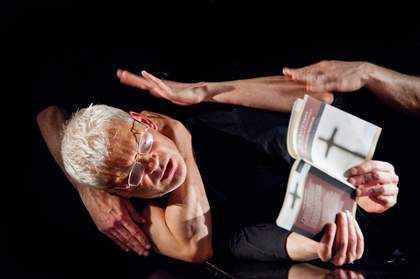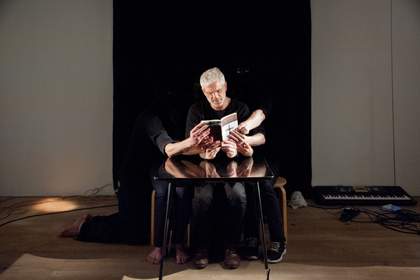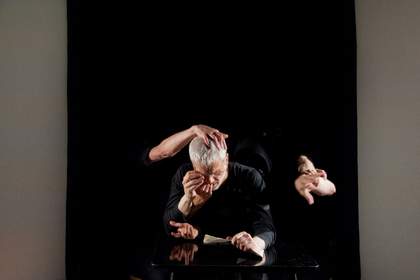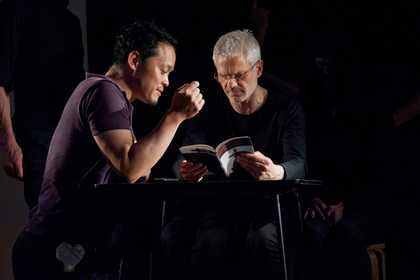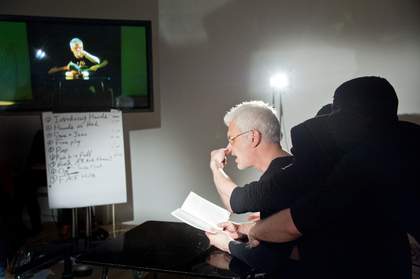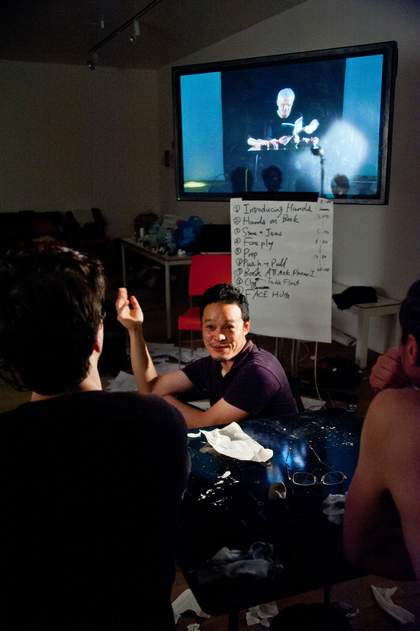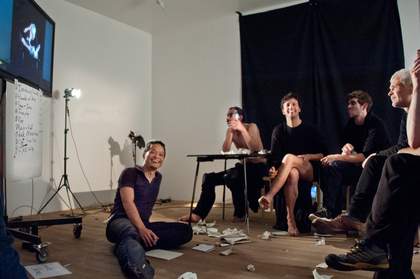Meiro Koizumi’s The Birth of Tragedy took place on 13 June 2013 as part of the BMW Tate Live: Performance Room series. It was designed to be performed only once for an audience watching via a live stream broadcast. For the piece Koizumi adapted his video installation, It’s a Comedy 2012, working with a small team of six hired actors over three rehearsal days. The Birth of Tragedy depicted an encounter in which a man trying to read aloud from a book was slowly interrupted and overpowered by seemingly disembodied limbs.
The central figure, a scholarly character, sat at a desk in the dimly lit space attempting to read aloud from Friedrich Nietzsche’s The Antichrist (1895). In It’s a Comedy, a performer read aloud from the trial judgement of Justice Radhabinod Pal, the only member of the international military tribunal for Japanese war crimes to find all the defendants not guilty. Koizumi changed the Performance Room text to Nietzsche’s radical tract because the Performance Room was ‘an abstract setting that needed an abstract book’.1 The Birth of Tragedy is the title of another of Nietzsche’s book, written a decade before The Antichrist. During the reading of the text, the other performers attempted to distract the reader, using their hands, paper, clay and sound effects. The props suggested representations of latent forms of artistic expression, such as music, sculpture and writing. The use of six performers in the Performance Room led to a dreamlike visual effect, particularly when multiple floating hands seeming to emerge disembodied from the darkness and crawl over the reader’s face. Nietzsche’s provocations, pronounced by the reader, were physically interpreted by these hands (and sometimes feet) as aggressive, molesting presences trying to overwhelm the reader. These performers, whose faces were never seen, stroked the reader’s face, tapped his chin, stuck their fingers up his nose and in his ears, drummed on the table and rubbed his hair and glasses. As time passed their disturbing actions built to a crescendo; they started to rip pages out of the book and throw them around. Experimental ambient music started to play at an increasing volume as the reader was gradually consumed, disappearing into the darkness behind the table. While choreographing and directing The Birth of Tragedy, Koizumi worked from preparatory sketches. He referred to these at the beginning and end of each rehearsal day. The sketches were used to make sure the visual appearance of the performance on screen was as effective as possible, in particular, ensuring the distribution of the body parts around the reader.
The Birth of Tragedy’s forbear, It’s a Comedy, evolved from a commission from the Japan Foundation in early 2012 for its Journey to the West exhibition in New Delhi. A group of curators invited Koizumi and five other artists to make a work around the relationship between Japan and India. During his trip, Koizumi was inspired by illustrations of Indian gods with multiple heads and limbs, particularly the disjuncture between their symbolic omnipotence and the practical realities of living in such a shape; ‘they can help many people with many hands – but at the same time if you really apply that to the real body it must be so hard to do one thing, to eat breakfast, the three of you together’.2
Koizumi utilised techniques of the absurd in order to create something uncomfortable and surreal, rather than humourous. ‘I’m not trying to be funny’, he said, ‘when people are confronted by something they don’t understand then people often laugh’.3
Philomena Epps
July 2016

